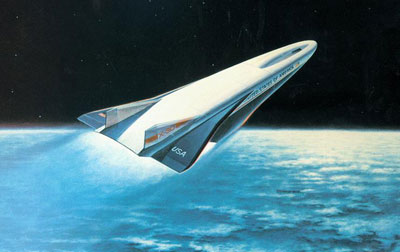|
|
 While the National Aerospace Plane effort failed to develop high-speed intercontinental transportation, a new prize might ecourage private ventures to try. (credit: NASA) |
The V-Prize: one hour to Europe
by Paul de Brem
Monday, August 27, 2007
Soon, it may only take an hour to get to Europe. At least that’s what the initiators of the V-Prize are hoping, which is why they’ve invented this new prize for the first manned craft capable of crossing the Atlantic in less than 60 minutes. Even though the competition won’t officially be launched till the beginning of 2008, the organisers wanted to unveil the basic idea for an article, which I published recently in Le Journal du dimanche.
“The craft will take off from the Mid-Atlantic Regional Spaceport in the state of Virginia,” hence the “V” in V-Prize, explained Jack Kennedy, chairman of the V-Prize Foundation, the organisation running the competition. “But for the time being we don’t know in which European country they’ll land after crossing the Atlantic.” The organizers want to give all candidate countries the chance to compete for the right to host such an important event.
The venture must be completed before July 1, 2013, the expiration date of the Spaceflight Liability and Immunity Act passed earlier this year by the state of Virginia to encourage the development of research on manned flights. According to this Act, a company organizing a space voyage cannot be held liable for personal injury to passengers who have signed a disclaimer.
As for the value of the prize, it will be “from $10 to $25 million”, according to Kennedy. The V-Prize Foundation is currently consulting potential sponsors, manufacturers, and public bodies to raise the sum. “Things are moving very fast,” said Megan Seals, one of the people in charge of the project.
The V-Prize was modelled on the Ansari X Prize, whose enormous success early this decade exceeded all expectations. Twenty-six companies in the aerospace industry took up the challenge. In 2004, SpaceShipOne, developed by Scaled Composites in California’s Mojave Desert, won the competition and the $10-million prize. It succeeded in carrying a man to an altitude of more than 100 kilometers twice within two weeks. However, the type of vehicle used in this case, was designed to land on the site where it took off. “Transporting passengers point-to-point via suborbital spaceflight is the next logical step,” said Seals.
| The V-Prize was modelled on the Ansari X Prize, whose enormous success early this decade exceeded all expectations. “Transporting passengers point-to-point via suborbital spaceflight is the next logical step,” said Seals. |
The types of aircraft capable of crossing the Atlantic in less than one hour will have rocket engines. Their average speed will be greater than 6,000 km/h and their maximum speed will reach Mach 15 or even Mach 20. “They will take off like space launchers, follow a ballistic trajectory like intercontinental missiles, reach an altitude of 100 to 200 kilometers and then land like gliders. At the height of the trajectory, the pilot will experience several minutes of weightlessness, then be subjected to accelerations of eight, nine or even ten g at the moment of re-entry into the Earth’s atmosphere, depending on the particular shape of the trajectory,” said Christophe Bonnal, a senior expert at the French space agency CNES. Bonnal is familiar with the constraints incumbent in this type of aircraft, having taken part in research on the Hopper Launcher, a European concept for a launcher of the future whose first stage will have wings and will land on Earth after following a ballistic trajectory.
It remains to be seen whether the V-Prize challenge is realistic or not. According to Kennedy, an attorney, “regulatory problems will have to be settled and some international treaties modified” in order to authorize this type of intercontinental flight. But, according to Bonnal, “the biggest difficulties will come from heating problems arising at the moment of re-entry to the Earth’s atmosphere. The craft will have to be protected by tiles and this very costly technology still has to be perfected”. This greatly reduces the chances of the V-Prize being won before 2013, although doubtless some people will try.
Paul de Brem is a science journalist who has specialized in space matters for 13 years. He works in France for newspapers such as Le Journal du dimanche, Le Figaro, and L’Express and television channels such as LCI and France 24. He is currently working on a book about space tourism.
|
|
